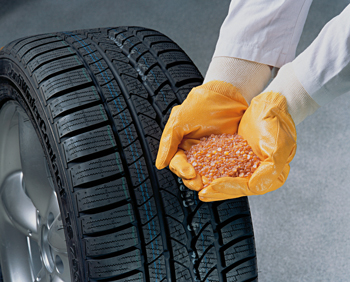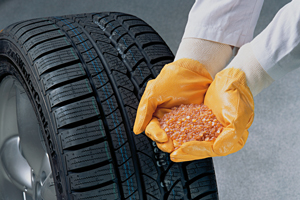There aren’t many products with a worse environmental image than tires. Too many people have seen huge piles of scrap tires, or worse still, burning tires that defy attempts to extinguish them. It’s a problem that’s hard to ignore, and, not surprisingly, tire manufacturers today seem to be very sensitive to the issue.
Tiremakers stress their commitment to continuous improvement in environmental management. They proclaim their determination to actively contribute to the protection of the environment and address the concerns of the public. Manufacturers are anxious to point out how they’ve organized their efforts around pollution prevention, compliance with legislation and environmental regulations, and continuing improvement of the environmental performance of their manufacturing operations.
Tire companies describe environmental protection as an important part of their corporate culture, a core value that is part of their everyday operations. But, what have they actually done about it?
One of their first steps was to analyze the total lifetime environmental impact of tires to help determine how it might be improved. What researchers found was that rolling resistance contributes the most to greenhouse gas emissions (in excess of 85%) because of the amount of extra fuel that tires cause engines to burn. Every additional gallon of oil that is burned to overcome rolling resistance adds 18 pounds of carbon dioxide to the atmosphere.
Initial efforts to develop low rolling resistance tires yielded improvements of about 5% in rotating friction, which boosted fuel economy by as much as 4% to 8%. Over the lifetime of a passenger tire, this resulted in savings of 10 to 80 gallons of gasoline.

Further improvements are tougher to come by, but a stated goal of several manufacturers is to improve fuel economy by 2% with each new generation of tires – without reducing traction or any of the tires’ safety characteristics. An example of one of the more successful fuel-saving technologies in the passenger tire segment is Goodyear’s Fuel Max Technology that, according to Jay Robinson, general manager of consumer tire marketing, features a proprietary, fuel-saving tread compound.
Because it involved replacing certain petroleum-based substances in tire construction, the efforts to build low-rolling resistance tires were only the first steps toward making them more environmentally friendly. Not an easy task because tire chemistry is so complex. Depending on the part of the tire – carcass, tread, sidewalls, belts, or liner – there are usually 30 or 40 chemicals in the various rubber compounds.
By weight, the tread compound of a typical passenger tire contains roughly equal amounts of natural rubber, synthetic rubber (made from oil) and carbon black (the soot-like reinforcing agent made by partially burning fossil fuels). These three ingredients usually make up about 85% of the tread compound; the remainder is a variety of chemicals that serve different functions.
Manufacturers first added silica fillers (surface-treated sand micro-particles) to replace some of the carbon black reinforcement. Silica fillers reduce the frictional heat generated by rubber compounds as the tire flexes, stretches and then recovers with each rotation.
Since the introduction of silica, tiremakers have turned increasingly to finding renewable raw materials to replace petroleum-based ingredients. Depending on the size, anywhere from four to 10 gallons of petroleum is required to produce most passenger tires. To replace some of the oil, manufacturers use a variety of sustainable, natural ingredients as substitutes. These include chemically toughened natural rubbers, vegetable-based processing oils, and fibers made of plant cellulose. Non-petroleum versions of various fillers, the additives necessary for the manufacturing process or to improve durability, continue to be developed.
Michelin employs sunflower oil in the tread compound of some of its all-weather tires to improve traction in winter conditions and shorten wet braking distances. Sumitomo produces tires that incorporate, in addition to silica fillers, specially modified natural rubber that grips better than unmodified versions, along with vegetable-derived processing oil and cellulose-based (rayon) casing fibers. Their stated goal is to produce tires that contain no petrochemical materials at all. Yokohama has also moved toward tires that are petroleum-free, using modified natural rubber compounds and processing oil derived from orange peels, a waste by-product of fruit juice processing.
In the Lab, In the Plant
Tire manufacturer efforts extend beyond the physical construction of tires. In addition to re-forestation programs to ensure the sustainability of rubber trees, tiremakers conduct biological and agricultural research to improve the quality of natural rubber and combat diseases in rubber trees. They are also looking beyond traditional rubber trees to develop new, potentially cheaper, and more sustainable crop sources of natural latex such as Russian dandelion, a central Asian weed variety, and guayule, a desert shrub that grows in the U.S. Southwest and Mexico.
Still other companies are turning to renewable synthetic rubbers made of precursor chemicals grown in vats by biotech-modified microorganisms. Other efforts include developing microbes that can grow an isoprene monomer used to make a synthetic rubber that mimics natural rubber (composed of polymerized natural isoprene).
Researchers have made micro-cellulose from various plant fibers; a promising alternative to the heavy and expensive silica mineral fillers now used to reduce rolling resistance. The lightweight micro-cellulose could save even more fuel if it can meet long-term durability requirements.
Michelin is working to eliminate volatile organic compound (VOC) emissions at their plants. They intend to move beyond regulatory requirements toward the eventual elimination of solvents and VOC emissions from their facilities. A priority, Michelin continues to deploy new production processes designed to use fewer solvents and emit fewer VOCs. They point to a 78% decrease in solvent use by their European passenger car and light truck tire manufacturing operations since they implemented the reduction project in 1992.
Goodyear continues its company-wide efforts to eliminate solvent use and emissions. Where solvents have been used in manufacturing processes and maintenance activities, Goodyear has established multifunctional teams to develop process changes that eliminate solvents where possible, or to find alternative materials. So far, 15 Goodyear plants have achieved zero solvent use and Goodyear has reduced global solvent use by 53% since 2009. They intend on driving solvent use in radial passenger and truck tires to zero, while achieving “best practice” levels in bias tires and other production lines.
Reduce, Reuse, Recycle
Another priority for tiremakers is reducing waste sent to landfills. Scrap rubber, textile plies and metallic plies used to manufacture tires are the main waste products generated by tire production. To the extent possible, manufacturers increasingly reintroduce their waste products into their production processes.
During the period of 2005-15, Michelin’s program to reduce the total weight of landfilled waste reduced the waste generated per ton of tires produced by 22% – from 308 pounds to 240 pounds. Over the same period, the weight of landfilled waste fell by 72% to 20 pounds from 73 pounds. Michelin is committed to the eventual reduction of the weight of generated waste by 30% and of waste sent to landfills by 95%.
Goodyear is even more aggressive, with a goal that no Goodyear manufacturing facility is to send any waste to a landfill. In 2006, Goodyear created its Zero Waste to Landfill initiative to reduce their environmental impact by requiring all of its manufacturing plants to reduce, reuse and recycle manufacturing waste. The program is intended to find the most efficient outlets for reusable scrap material and to achieve the most beneficial use for that material.
As a result, more material is being recycled or used as fuel and the sale of by-products returns revenue to help fund further improvements. Goodyear’s goal is to maintain the Zero Waste to Landfill policy while reducing the amount of waste incinerated or used for heat recovery. It uses continuous monitoring and auditing to ensure compliance. If Goodyear discovers any deviation from the program, the company takes immediate corrective action, up to and including the termination of vendor contracts.
In its production process, Continental’s goal is to reduce energy and water consumption annually while lowering CO2 emissions and waste by 3% per year.
At many tiremakers’ manufacturing facilities, the ongoing installation of new precision production machinery that can hold much tighter manufacturing tolerances allows them to produce tires that have little extra weight beyond the design specifications. Controlling the production process more carefully minimizes waste and produces lighter tires that are easier to rotate and save fuel.
The tire industry as a whole is trying harder than ever to recycle more of the estimated 300 million used tires that are discarded annually in the U.S. Used tires can be 100% recovered, as either energy or raw materials. They are reused as filling material, soundproofing, railroad ties, drainage products and synthetic surfaces for sports fields and playgrounds.
Tire recycling has grown markedly in recent years and small quantities of processed rubber are reused in some tires, but these efforts are limited by the quality of the rubber feedstock. However, a process is under development that uses liquid nitrogen to freeze scrap tires before grinding it into pulverized rubber feedstock that could go into tires.
Overall, while tires and their environmental legacy remain black, more fuel-efficient designs, more bio-sourced raw materials, better production methods and stronger recycling programs are making the industry’s future greener.













